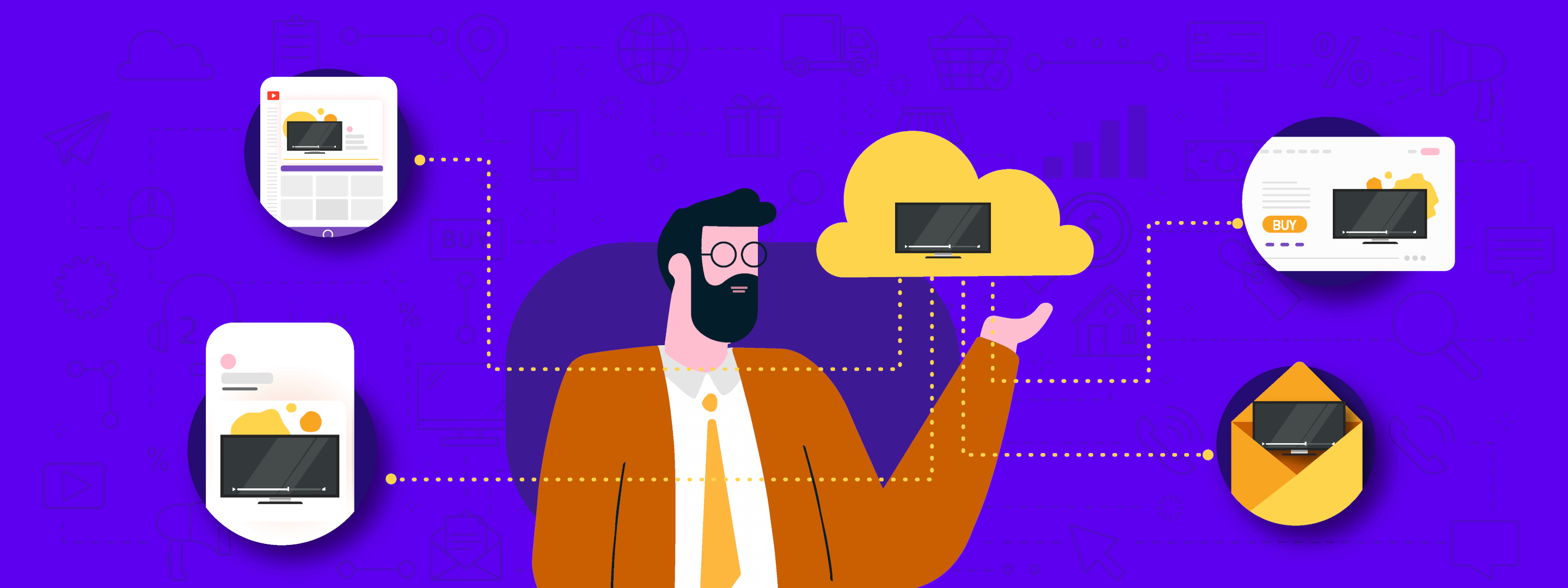Welcome to WebEngage! You’re now one step closer to becoming a Retention champion! Please press play to listen to the audio version of the blog.
Customer journey to buying a product is not linear- they interact with a brand on different channels (website, mobile app, etc.), look for reviews, and have queries that need to be resolved. A brand needs to garner customer attention, build a connection using stories, and drive a seamless experience to enable purchase.
Each channel lends itself to different formats of storytelling. It also enables brands to gather data about the user so that experiences can be personalized. Users coming to the brand’s online platform from different channels behave differently. But how does it actually work?
Let’s get a bit deeper into this.
Rupen wants to buy a TV and searches for ‘Best 55 inch LED TV’ on Google. He ends up landing at an e-Commerce store, browses through a few TVs, and manages to shortlist one. After a few hours, he goes through the reviews on tech and electronic product websites to research more on the brand and the model that he has narrowed down upon. He also chats with the brand representative to understand the details on warranty before going back to the e-Commerce site to purchase the TV, but not before he has searched for a discount coupon on a deals aggregator’s website.
Shikha, on the other hand, decides that it’s time to upgrade her TV after watching a brand’s video ad on Youtube multiple times. She also sees the brand ad on Instagram where she learns about specific features of the TV. She starts her search by keying in ’55 inch TV reviews’ before ending up on an e-Commerce store. Over the next week, she gets two emailers and a push notification from the e-Commerce site and starts seeing the TV ad more frequently on Instagram. After 8 days of thinking through it, she ends up buying the TV.
Now multiply this by a million users with each one of them having a different path to purchase. Smart marketers personalize the journey for each user. They deploy multichannel marketing as a core strategy to reach the audience through various communication channels throughout the user journey.
Multichannel marketing brings scalability in your marketing strategy, tactics, and operations. It enables you to be present across channels seamlessly. Additionally, it helps you build brand awareness, and drive conversions.
Download eBook – Get to know all about the state of Customer Engagement & Retention tools.
Multichannel marketing automation has become table stakes
To achieve your growth targets, you need to target every prospect, get them on the lead page, drive conversions & repeat orders, and reduce churn. It becomes impossible to deliver on all these promises without marketing automation.
You constantly need to work hard to drive sales by improving top of the funnel, increasing conversions, improving customer retention, and driving repeat orders. Driving scale efficiently requires you to seriously look at marketing automation as an integral part of the marketing strategy. Using a multichannel strategy can drive revenues up by 190%.
Don’t take my word for it. Take a look at the stats below.
 Source: Shopify
Source: Shopify
A multichannel strategy needs to be backed by a marketing automation platform so that customer experience is not impacted and your marketing team’s productivity can be enhanced. To be able to stay relevant (nay, thrive) in this environment, you can look towards multichannel marketing automation to solve these 3 core areas for you:
1. Personalization
Users have always expected personalized experience from brands. For brands that are small and have not yet achieved scale, personalization is done by sending a personalized card or scheduling a call from the management. As companies grow, delivering personalized experiences becomes difficult. With technology advancement and data analytics evolving rapidly, you now have access to marketing automation platforms that can enable you to engage with customers across all stages of their lifecycle.
The personalization journey today begins right from the time you are trying to create brand awareness. Users prefer different mediums to interact with the brand. You have access to data to segment users in real-time and deliver personalized experiences at scale. It is only by using the multichannel marketing automation platforms that you can deliver mass personalization to millions of users simultaneously. Otherwise, how would you segment these millions of users and then map the right communication to be sent?
If you are a marketer not leveraging marketing automation, then I’m sorry to say, but you will only be fighting an uphill task when competition gears up with the right tools.
Moving down the funnel, you can use marketing automation to drive customer retention and curb churn to capture more value. It’s best to use the platform to drive context-specific messaging for each user so that he/she moves toward becoming a high LTV customer. Specific campaigns and messaging can be used to retarget:
- First-time customers viewing trending and recommended products,
- Visitors who have viewed a product but not bought anything in the past week,
- Recurring customers to access early sales
- Long-term customers to get them to enroll in referral and loyalty programs
2. Orchestration
There are numerous channels that can be used to interact with the user, like:
- Website assets,
- App native assets,
- Paid ads across search, social, display and video,
- Email,
- SMS,
- Web & App notifications,
- Pop-Ups,
- Chatbots,
- Interactive Voice Response (IVR) & Manual Calling,
Each of these channels can be used for specific communication to the user. Users may prefer a channel over the other, but it’s your job to identify and use the right channel for the right user at the right time. And that’s where a marketing automation platform can help you in orchestrating send-time automation based on each user’s interaction data so that the user reads the communication, engages with your brand, and moves closer to a transaction.
Consequently, there can be multiple user segments in different parts of the funnel:
- App installed but not signed up,
- Signed up but not transacted,
- Only transacted once (never purchased again),
- Reached a specific milestone,
- Failed to complete a transaction.
Using a marketing automation platform, you can also build lifecycle and trigger-based campaigns. At any given point in time, B2C brands have over 100 campaigns running simultaneously. For example, these campaigns can be used to:
- Cross-Sell
- Upsell
- A/B Test
- Drive Referrals
- Drive purchase using a discount coupon or other incentives
- Reduce churn rate
- Winback/Reactivate users
The campaigns need to be orchestrated so that a user is not bombarded with messages throughout the day across multiple channels. To be able to execute such complex scenarios, the automation platform enables company-wide rules like no more than 2 messages per user per day. Each campaign can be given a priority based on the highest probability or action by the user or even business goals. Not using a multichannel channel’s orchestration capabilities will cause customer dissonance and not drive marketing campaigns forward in a holistic manner.
A marketing automation platform can integrate data collected from various touchpoints to enable timely campaigns across channels. Machine learning capabilities built into the marketing automation platform can also help customize consistent messaging across various channels.
3. Access to data
Data lays the foundation for leveraging multichannel marketing automation. Today, you can get access to actionable data. There is no requirement to have a 10 member data analytics team just for marketing. Automation platforms do much of the heavy lifting for data analysis by providing enriched views of cohorts, flows, and funnels. And creating a 360-degree view of users.
Visualization of data is very important for you to make decisions faster. Data access plays a key role to enable growth so that you can run multiple marketing experiments in parallel.
An insight after having worked with multiple marketing teams over the years:
If you have to put in a request to the analytics team for a data view, then the campaign priority is informally lowered due to elongated timelines. Share on X
Automation platforms have started building good machine learning models to enable channel and product recommendations. You can now trust automation platforms for conversion attribution, send-time automation, and channel optimization. This saves you considerable time to take campaigns live and scale them. You can now allocate more time to designing multiple experiments and enabling the team to run A/B tests. More importantly, you free up time to focus on storytelling, creatives, and content which help build an emotional bond with the user.
Conclusion
Multichannel marketing automation combines technology and data to engage users better and increase marketing ROI. With the data layer as the foundation to assimilate user data and drive analytics, it is possible to execute multiple campaigns simultaneously. Personalization and orchestration can be easily enabled by a marketing automation platform to give you the right tools to execute your strategy. Most importantly, users engage with the brand at a convenient time during the day over a channel that the user prefers. This ultimately helps build stellar customer experience, a cornerstone to driving business growth.
Take a demo with WebEngage today to implement these use cases, boost sales, and skyrocket your revenue.


































 Diksha Dwivedi
Diksha Dwivedi
 Vanhishikha Bhargava
Vanhishikha Bhargava
 Surya Panicker
Surya Panicker



